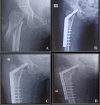A Comparative Study of Functional Outcome Following Dynamic Hip Screw and Proximal Femoral Nailing for Intertrochanteric Fractures of the Femur
- PMID: 35518518
- PMCID: PMC9066962
- DOI: 10.7759/cureus.23803
A Comparative Study of Functional Outcome Following Dynamic Hip Screw and Proximal Femoral Nailing for Intertrochanteric Fractures of the Femur
Abstract
Introduction Intertrochanteric fractures are common in the old age group. The goal/aim of the treatment for intertrochanteric fractures will be to nearly restore pre-injury condition as early as it is possible. Dynamic hip screw (DHS) and proximal femoral nailing (PFN) have been the two standard treatment methods used for treating these kinds of fractures. The main goal of this proposed study was to compare functional outcomes of two available fixation devices for inter-trochanteric fracture using Harris hip scoring. The aim of this study is to compare the functional outcome of the DHS and PFN for the treatment of Intertrochanteric hip fractures achieved by the patient based on Harris hip score. Methods and materials The clinical methodology for the study consists of 46 cases of Inter-trochanteric fractures of femur that meet the inclusion criteria of patients aged above 45 years diagnosed with closed intertrochanteric fractures that are less than three weeks duration who were able to walk prior to fracture and exclusion criteria, admitted to R L Jalappa Hospital, Tamaka, Kolar between November 2019 and November 2021. The patients were divided into two groups, group A treated with DHS and group B treated with PFN and followed up at six weeks, 12 weeks, and 24 weeks based on the functional outcome on the 24th week using Harris hip score. Results A total of 46 patients were included in the study. The mean age in Group DHS was 61.09 ± 11.69 and in Group PFN was 65 ± 14.98. In the group of DHS, nine out of 23 patients were male and 14 out of 23 patients were female patients. In a group of PFN, 12 out of 23 patients were male and 11 out of 23 patients were female. The mean six weeks score in Group DHS was 34.43 ± 3.23 out of 100 and in Group PFN was 34.35 ± 2.5 out of 100. The mean Harris hip score in Group DHS was 84.3 ± 7.68 out of 100. The mean Harris hip score in Group PFN was 89.26 ± 6.53 out of 100. In Group DHS, 52.17% had injuries on the left side and 47.83% had on the right side. In Group PFN, 39.13% had Injury on the left side and 60.87% had on the right side. In Group DHS, results were excellent in 34.78% (eight patients), good in 43.48% (10 patients), fair in 17.39% (four patients out of 23 patients), and poor in 4.35% (one patient). In Group PFN, results were excellent in 56.52% (13 patients), good in 34.78% (eight patients), and fair in 8.70% (two patients). Conclusion From the study, it can be concluded that PFN had a better outcome in intertrochanteric fractures compared to DHS. The highest percentage of subjects in the PFN group had excellent to a good outcome and none of them had poor outcomes when compared to the DHS group. PFN group had higher scores of Harris hip score at 12 weeks, 24 weeks, and at the end of follow-up.
Keywords: dynamic hip screw; functional outcome; harris hip score; intertrochanteric fractures; proximal femoral nailing.
Copyright © 2022, Prakash et al.
Conflict of interest statement
The authors have declared that no competing interests exist.
Figures



Similar articles
-
Type II Intertrochanteric Fractures: Proximal Femoral Nailing (PFN) Versus Dynamic Hip Screw (DHS).Arch Bone Jt Surg. 2016 Jan;4(1):23-8. Arch Bone Jt Surg. 2016. PMID: 26894214 Free PMC article.
-
Evaluation of Functional and Radiological Outcome of Different Cephalomedullary Nail Designs in Intertrochanteric Fractures of Femur.J Orthop Case Rep. 2025 Mar;15(3):244-249. doi: 10.13107/jocr.2025.v15.i03.5402. J Orthop Case Rep. 2025. PMID: 40092258 Free PMC article.
-
Surgical Treatment of Type 31-A1 Two-part Intertrochanteric Femur Fractures: Is Proximal Femoral Nail Superior to Dynamic Hip Screw Fixation?Cureus. 2019 Feb 20;11(2):e4110. doi: 10.7759/cureus.4110. Cureus. 2019. PMID: 31058004 Free PMC article.
-
Proximal femoral nailing is superior to hemiarthroplasty in AO/OTA A2 and A3 intertrochanteric femur fractures in the elderly: a systematic literature review and meta-analysis.Int Orthop. 2020 Apr;44(4):623-633. doi: 10.1007/s00264-019-04351-9. Epub 2019 Jun 14. Int Orthop. 2020. PMID: 31201487
-
Comparative effectiveness research on proximal femoral nail versus dynamic hip screw in patients with trochanteric fractures: a systematic review and meta-analysis of randomized trials.J Orthop Surg Res. 2022 Jun 3;17(1):292. doi: 10.1186/s13018-022-03189-z. J Orthop Surg Res. 2022. PMID: 35658909 Free PMC article.
Cited by
-
Comparing Intramedullary Nails versus Dynamic Hip Screws in the Treatment of Intertrochanteric Hip Fractures on Post-operative Rehabilitation Outcomes - A Systematic Review and Meta-Analysis.Geriatr Orthop Surg Rehabil. 2025 Jun 17;16:21514593251350490. doi: 10.1177/21514593251350490. eCollection 2025. Geriatr Orthop Surg Rehabil. 2025. PMID: 40535322 Free PMC article. Review.
-
A Comparative Study of Dynamic Hip Screws and Proximal Femoral Nails in Intertrochanteric Fractures.Cureus. 2024 Apr 26;16(4):e59063. doi: 10.7759/cureus.59063. eCollection 2024 Apr. Cureus. 2024. PMID: 38800311 Free PMC article.
-
Proximal femoral nail anti-rotation vs dynamic hip screws decrease the incidence of surgical site infections in patients with intertrochanteric fractures: A meta-analysis.Int Wound J. 2023 Oct;20(8):3212-3220. doi: 10.1111/iwj.14200. Epub 2023 Apr 24. Int Wound J. 2023. Retraction in: Int Wound J. 2025 Mar;22(3):e70302. doi: 10.1111/iwj.70302. PMID: 37095692 Free PMC article. Retracted.
References
-
- Pertrochanteric femoral fractures treated with a dynamic hip screw or a proximal femoral nail. A randomised study comparing post-operative rehabilitation. Pajarinen J, Lindahl J, Michelsson O, Savolainen V, Hirvensalo E. https://pubmed.ncbi.nlm.nih.gov/15686241/ J Bone Joint Surg Br. 2005;87:76–81. - PubMed
-
- Stable fixation of intertrochanteric fractures. Kaufer H, Matthews LS, Sonstegard D. https://pubmed.ncbi.nlm.nih.gov/4847237/ J Bone Joint Surg Am. 1974;56:899–907. - PubMed
-
- Sunder Rao PSS, Richard J. A Manual for Students in Health Sciences. New Delhi: Prentice hall of India; 2006. An Introduction to biostatistics; p. 160.
LinkOut - more resources
Full Text Sources
